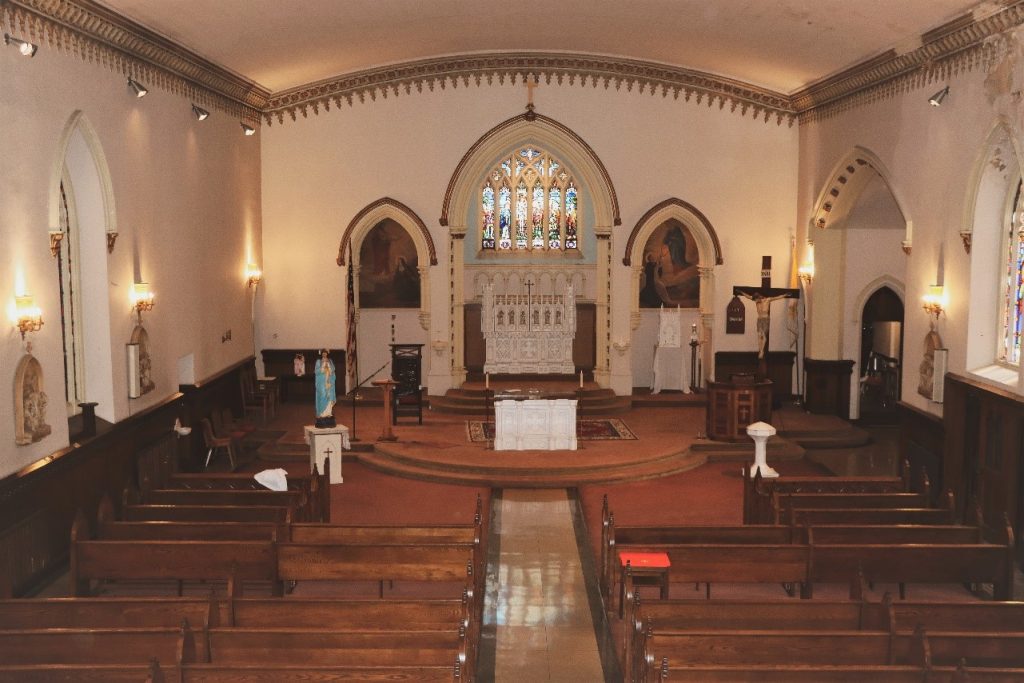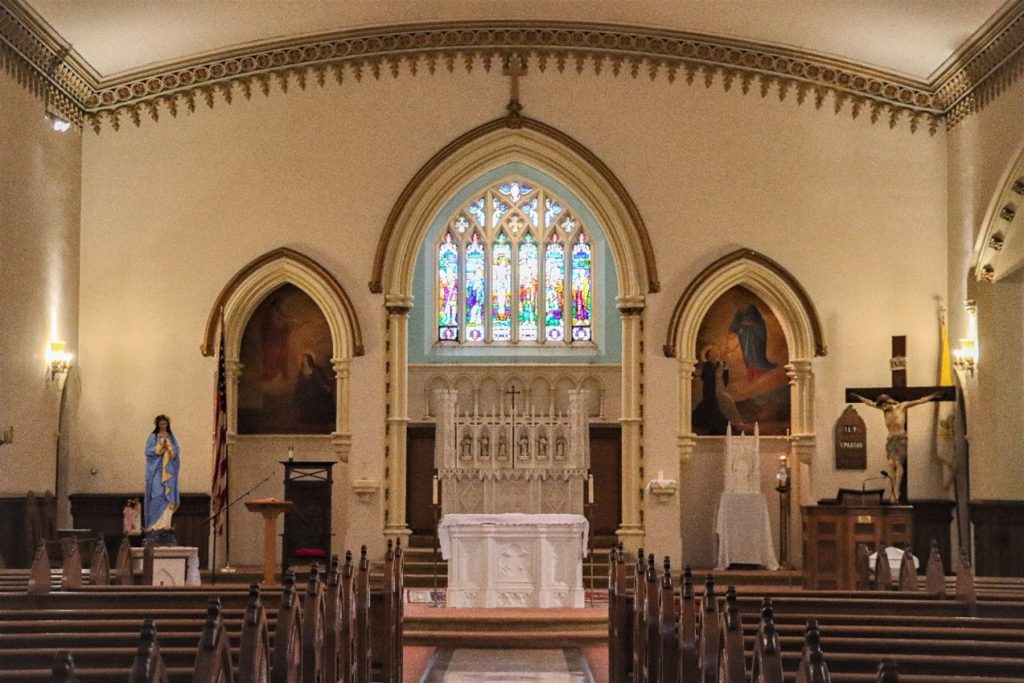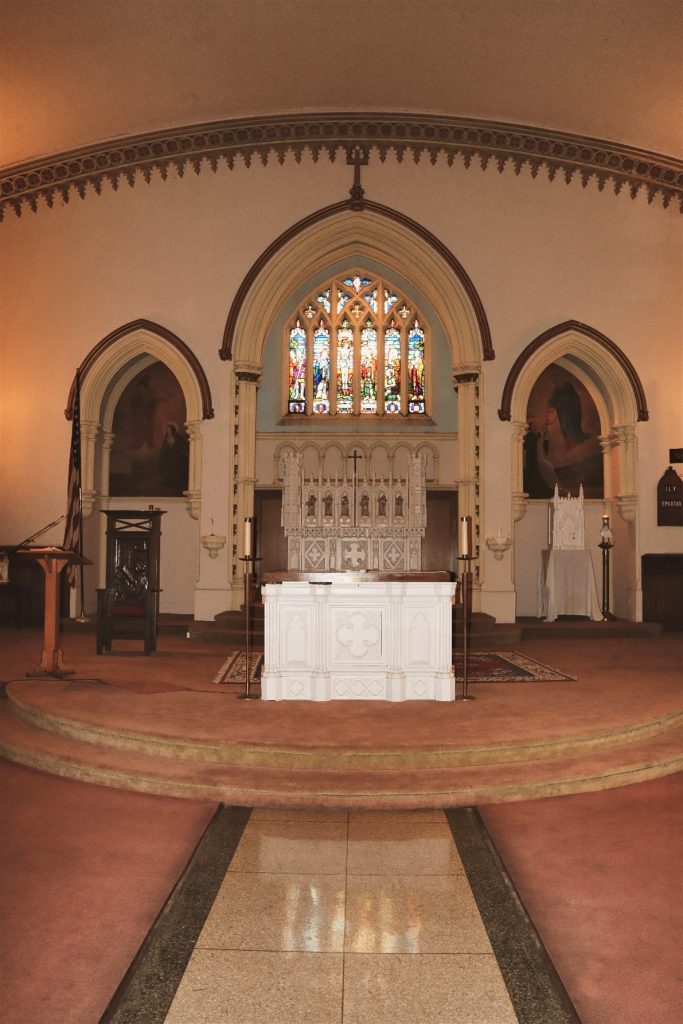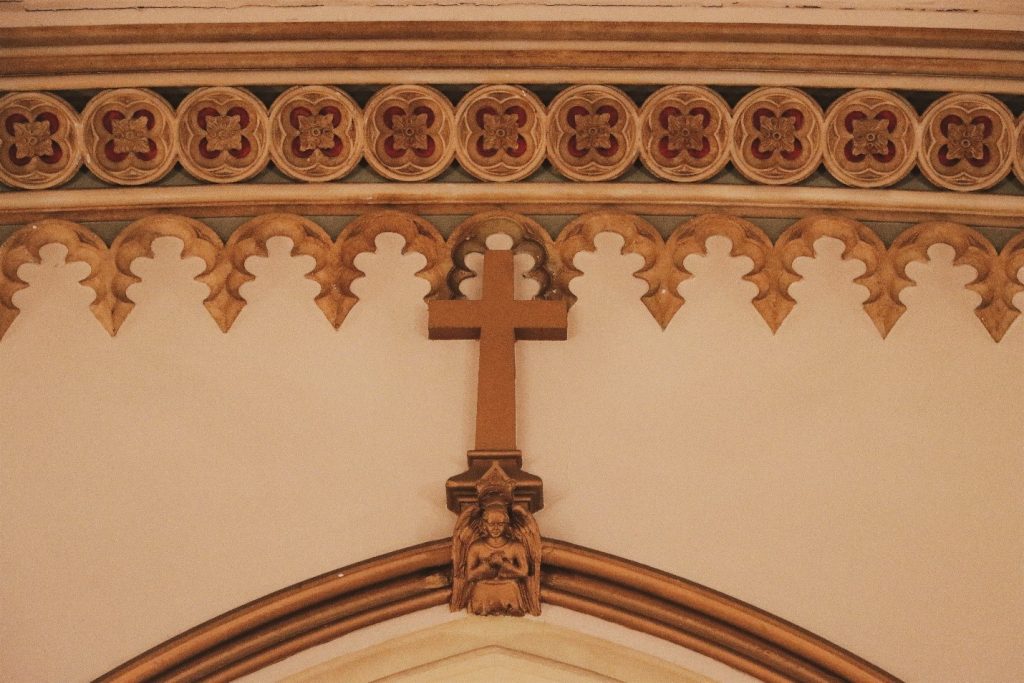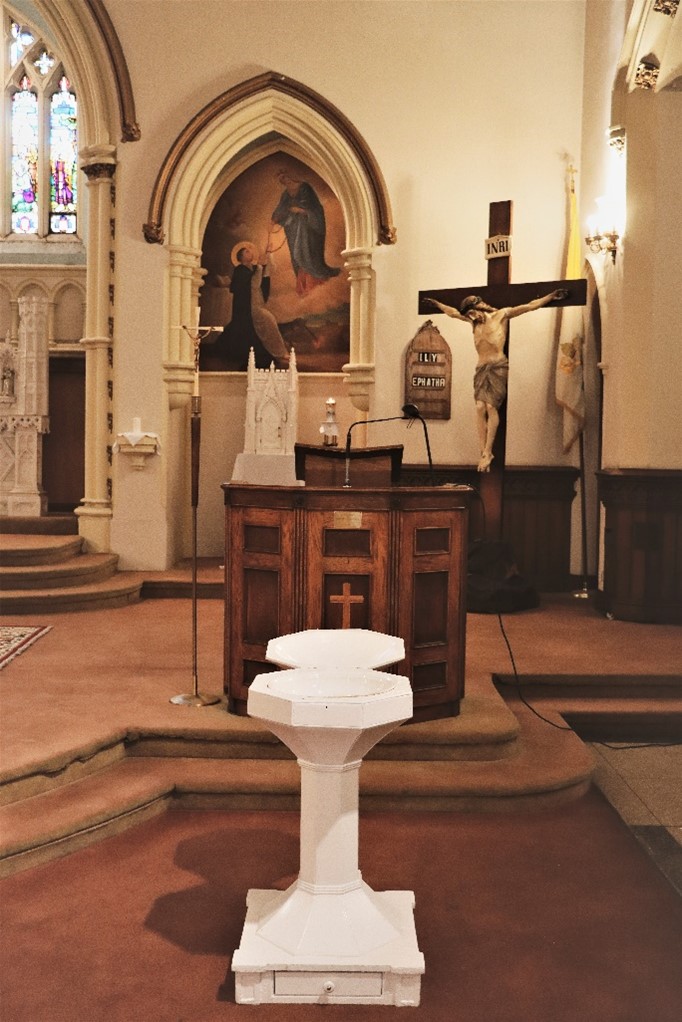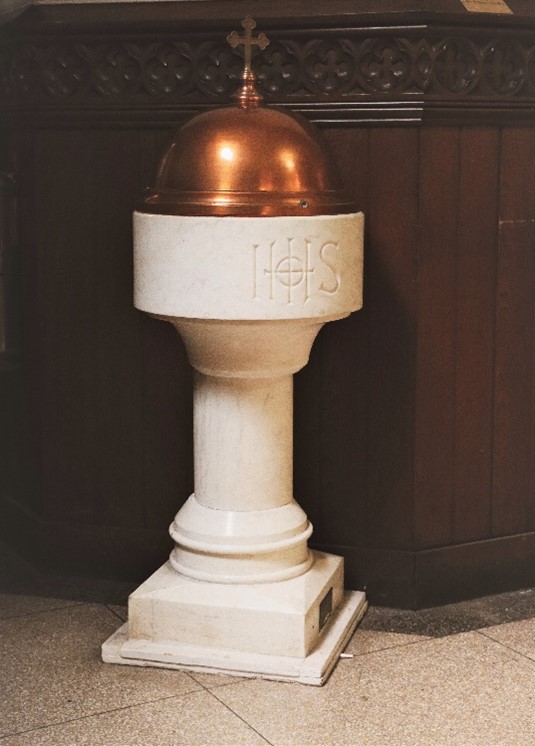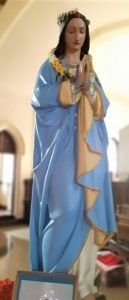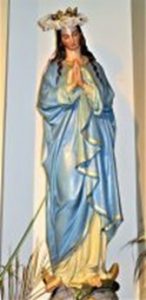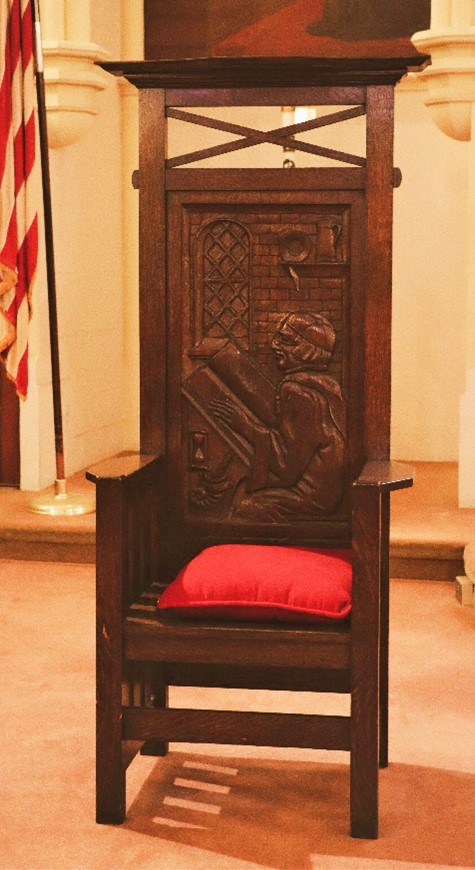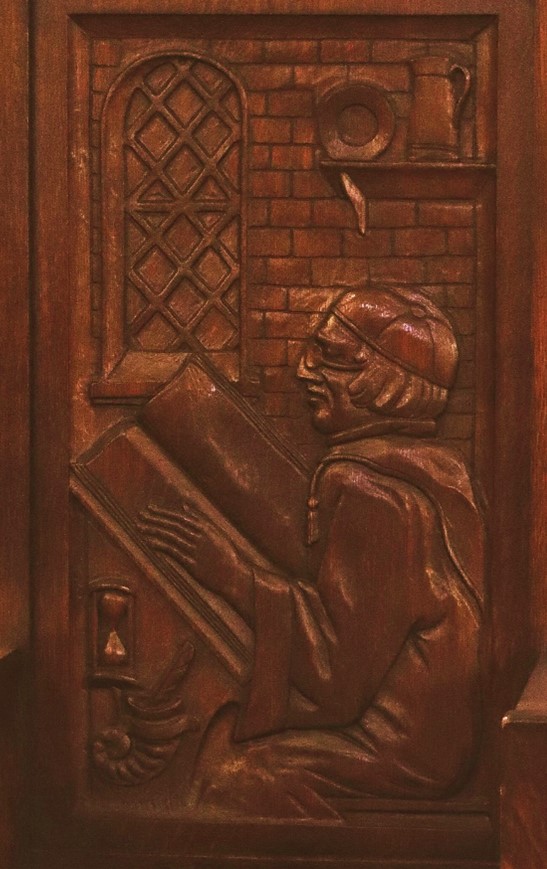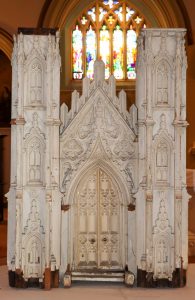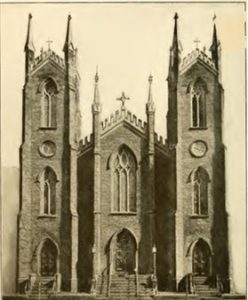The Interior of St. John’s
From the altar looking towards the rear of the church.
From the Rear of the Church Looking Towards the Altar
The Apse Window

The apse window, probably installed in the renovations of the 1930s, is similar in style to the chapel windows but clearly not art deco. It consists of six lancets arranged in three pairs of two each.
The theme is the crucifixion. The figures are, from left to right: Soldiers and an unidentified male figure (perhaps St. Peter lurking in the background); Our Blessed Lady; Christ on the Cross; St. John, Mary Magdalene holding a jar of oil and another woman, probably Mary the wife of Cleophas, who is mentioned in the Gospels as being present at the crucifixion; and last, Joseph of Arimathea, the man who assumed responsibility for the burial of Jesus after his crucifixion.
The shields along the base of the window represent St. John, the patron of the church; the Triumph of the Cross; and the Old Testament. From the left, the first shield depicts a snake emerging from a chalice. A tradition says that, while in Ephesus, St. John was offered a glass of poisoned wine. Before drinking, he blessed the drink, and the poison came out of the cup in the form of a small green snake.
The next shield shows a snake wrapped around a cross. This symbolizes the triumph of the cross over Satan, depicted as a snake in the Garden of Eden, and the triumph of Christ over Original Sin.
After two dedicatory scrolls, a shield shows an eagle emerging from a cauldron. A tradition tells us that Emperor Domitian tried to kill John by boiling him in oil, but an angel spared John, whose symbol is the eagle, and he emerged from the cauldron of oil and continued to preach.
The last shield shows a Torah scroll. The Torah is the compilation of the first five books of the Hebrew Bible, namely the books of Genesis, Exodus, Leviticus, Numbers and Deuteronomy. It is known as the Pentateuch or the Five Books of Moses by Christians. It is also known as the Written Torah in Jewish tradition. Here it symbolizes that Christ fulfilled all of the prophecies of the Hebrew Scriptures. Fittingly, it is placed below Joseph of Arimathea.
The Entrance Transom Window
The transom window is indicative of other small windows in the vestibule and the sacristy of the church.
The Sanctuary
he furnishings of the sanctuary chiefly are a “re-cycling” of existing pieces from various eras of the parish. The Altar of Sacrifice (above) had served as one of the side altars.
The Tabernacle
The Tabernacle had served as a side altar tabernacle. It is set in a niche that now has the painting of the Blessed Virgin Giving the Rosary to St. Dominic.
The Baptistery
The Statue of the Blessed Virgin Mary
The Blessed Virgin Mary is honored under many titles. These almost identical statues, crafted in Munich about 1850, represent Mary under the title of the Immaculate Conception. The three statues are almost identical: each at one of the oldest churches in Newark, St. John’s, St. Mary’s (Newark Abbey), and St. Patrick’s Pro-Cathedral. The St. John’s statue depicts Mary without a crown; the Pro-Cathedral statue is crowned; the Newark Abbey statue is monochrome (unpainted).
The statues in St. John’s and St. Patrick’s have been repainted, probably several times. The St. Patrick’s statue last was repainted in 1930. Both need restoration.
Like the three churches, the statues are Gothic Revival in style, each showing a graceful figure with downcast eyes. The earth and the moon at her feet refer to the words of the Book of Revelation (12: 1) describing “a woman clothed with the sun, and with the moon under her feet and a crown of twelve stars upon her head.” The snake recalls the words of Genesis 3:15, “I will put enmity between you and the woman, and between your offspring and hers; he will strike your head, and you will strike his heel.”
On December 8, 1854, after he had consulted the bishops of the world, Pope Blessed Pius X pronounced and defined the Immaculate Conception of the Blessed Virgin Mary.
The statue from Newark Abbey was damaged in the anti-Catholic riots in Newark in 1854. On September 5, 1854, the Orange Association, also known as the American Protestant Association, marched 3,000 strong through Newark. St. Mary’s Church on High Street was wrecked and looted. Within St. Mary’s a damaged statue of the Blessed Virgin remains as mute reminder of this outrage. These statues recall the earliest years of Catholicism in Newark and probably are the oldest Catholic religious statues in New Jersey. They are of inestimable historical significance.
The marchers “rushed pell-mell upon the church, forced the doors, beat in the windows, tore up the seats, demolished the altar and the emblems, and put the organ very much out of tune, so that it can scarcely be an organ again. The whole interior of the Church speedily became a mass of ruins. The outer shell of the building is all that remains of it. A building on Shipman-street was also attacked, and the windows broken in.” 77 The extent of destruction to the interior and exterior of the church from the marchers was extensive: The fences are torn down, the windows and doors shattered, the shrubs about the door crushed and broken; and in the interior, the altar overturned, the sacred utensils and sacerdotal robes strewed around and trampled upon – the organ broke to pieces. The images, consisting of a costly Munich figure of the Madonna, and crucifix corresponding, together with the pictures, altar piece, and a splendid holy water font were also destroyed. – New York Times, September 6, 1854.
The Chair with the Monk
In the sanctuary area of St. John’s there is a very unusual chair, often used as the presider’s chair. The back of this chair features the figure of a monk wearing a skullcap, reading in a library or a scriptorium. He is seated, gazing at an open book on an easel. He is wearing primitive eyeglasses. When you look carefully you can see an hourglass on the lower left below the easel. The background consists of a brick wll and a Romanesque diamond leaded glass window. On the upper right of the wall there is a dish and a pitcher.
The origin of this chair and how it came to St John’s is a mystery.
The Life-Size Crucifix
A magnificent crucifix is placed to the right as you face the altar. The cross is a beautiful example of the church art of the 19th century. Such a large crucifix was a fixture in most churches in past years. The custom was to pray before it after receiving communion. The prayer was placed on a card near the crucifix.
Prayer before the Crucifix
Look down upon me, good and gentle Jesus,
while before Thy face I humbly kneel and,
with burning soul,
pray and beseech Thee
to fix deep in my heart lively sentiments
of faith, hope and charity;
true contrition for my sins,
and a firm purpose of amendment.
While I contemplate,
with great love and tender pity,
Thy five most precious wounds,
pondering over them within me
and calling to mind the words which David,
Thy prophet, said of Thee, my Jesus:
They have pierced My hands and My feet,
they have numbered all My bones.”
Amen.
The “Remnants”
The Altar Rail
The Altar Rail surprisingly was saved during the renovations of 1969. Currently, it is set in the rear of the church, behind the last row of pews. It is composed of bronze gates with the alpha and omega, and a bronze rail set on onyx pillars and topped with a marble hand rest. Judging from the dates of existing photographs the altar rail was installed in the 1930s.
The “Reredos”
The current “Reredos” is a composite of the mensa of the original main altar, and pieces of the original reredos. These include the two towers that Father Moran added to the main altar, hoping to eventually add them to the façade of the church.
Among the pieces “salvaged” during the 1969 “renovation,” are parts of the original reredos that depicted the façade of the church with the towers that Father Moran hoped to add. Among these “remnants” is the central tabernacle of the original reredos, a representation of the original façade of the church, complete with flamboyant decorations. It is in the sacristy.

